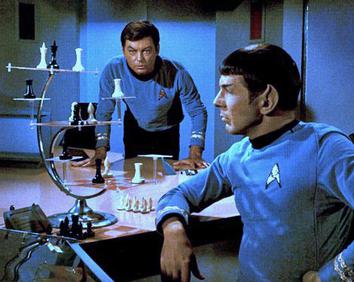In other words, remove the white first move, and every move of the game is made in pairs simultaneously.
You would need to have rules settling conflicts, such as two pieces of equal strength trying to move to the same square.
It would have to settle each conflict fairly.
For example if two opposing pawns try to move to the same square the rule could be that each pawn must move to the first open square to the square's right from each players perspective. If no open square is available then the play moves to the player's first open space left.
Perhaps a rule of two unequal pieces moving to the same square, if a stronger piece is used, that one takes the weaker, otherwise as above.
Madness, or possible, or a mess?
The way you're describing this game, I'm not sure how that would work at all.
Perhaps a rule where if two pieces of equal strength try to move to the same square, neither one makes it?
Or, both stop one square short, but there would need to be a special rule for determining on which square a knight would stop?
The quick version:
Each player's turn consists of 10 moves (except: White's first turn is five moves), although a player can end a turn early
No piece can be moved twice in a row in the same turn, except if the piece made a capture or the king was put in check; the king cannot move immediately after a castling move, but the castling rook can
When a piece is captured, the opponent has the option of making a move to capture the piece that made the original capture
When the opposing king is checked, the opponent has one move to get the king out of check (if he can't, it's checkmate)
Quote: ThatDonGuyI have a feeling this game is going to get messy early on, if there are too many pieces next to each other.
Perhaps a rule where if two pieces of equal strength try to move to the same square, neither one makes it?
Or, both stop one square short, but there would need to be a special rule for determining on which square a knight would stop?
As people might guess I was trying (as simply as possible) to give each side equivalency by both moving at the same time. And then only applying any rules necessary to resolve difficulties inherent in the game variation.
My other thought is, it would make the game even more difficult to play.
Quote: AxelWolf
I seem to distinctly remember playing against a computer in chess was a fantasy at the time
Quote: odiousgambitI seem to distinctly remember playing against a computer in chess was a fantasy at the time
Late 1960s, perhaps, but the Atari 2600 had a chess cartridge (not very good, mind you, and that was even in its "10 hours a move" mode), and chess was pretty much standard on every Unix system. The only problem was, you couldn't promote pawns to anything except queens. (There was also a glitch in the Unix typesetting software's chess "font"; one particular piece on one particular color of board would print as a large @ symbol.)
Quote: ThatDonGuyLate 1960s, perhaps, but the Atari 2600 had a chess cartridge (not very good, mind you, and that was even in its "10 hours a move" mode), and chess was pretty much standard on every Unix system. The only problem was, you couldn't promote pawns to anything except queens. (There was also a glitch in the Unix typesetting software's chess "font"; one particular piece on one particular color of board would print as a large @ symbol.)
at first I thought you meant the Atari 2600 was around in late 1960s ... but I realize now you mean 'whenever that was it might have been the first' or somesuch
"The Atari 2600 is a home video game console released in September 1977 " per wikipedia article, just for the record
PS:decided to look some stuff up. Early pioneers realized it would be in the future. Wikipedia article skips history, the addition to that source of information waiting to be written there it seems.
There's the below, some interesting stuff which I shortened with mucho ellipses:
Quote: linkIn 1951, Turing tried to implement his “Turbochamp” program...He never completed the task. However, his colleague wrote a chess playing computer program for the Ferranti computer that solved simple mates-in-two moves... In 1946 the Hungarian/American mathematician John von Neumann was given the task... a giant machine called MANIAC I was delivered. It was filled with thousands of vacuum tubes and switches [1950] In 1957, Alex Bernstein...With three colleagues... created a chess program at the Massachusetts Institute of Technology... on an IBM 704, one of the last vacuum tube computers. It took about eight minutes to make a move....it played a ‘passable amateur game. ... On January 21-23, 1967, MacHack VI played in the Massachusetts Amateur Championship in Boston. It was the first time an electronic computer played chess against human beings under regular tournament conditions.’ [I'd say approx the time Spock was shown playing the computer on Star Trek]
So I stand corrected on my original comment!
http://hightechhistory.com/2011/04/21/a-history-of-computer-chess-%E2%80%93-from-the-mechanical-turk-to-%E2%80%9Cdeep-blue%E2%80%9D/



